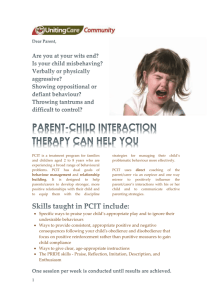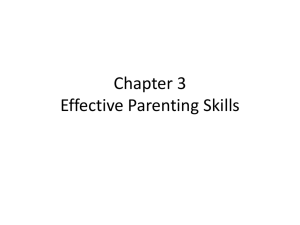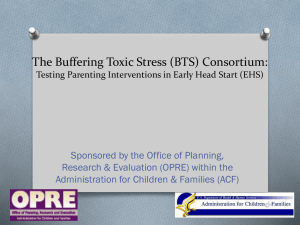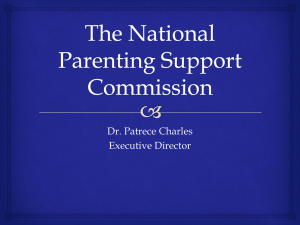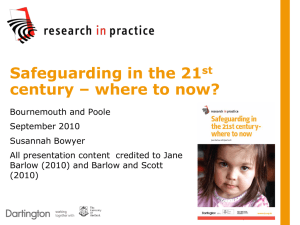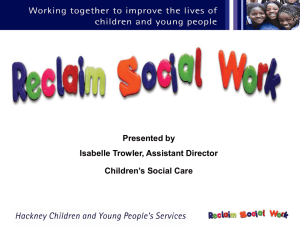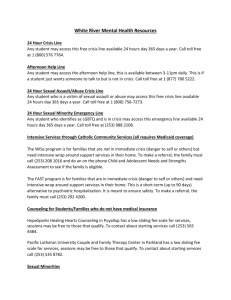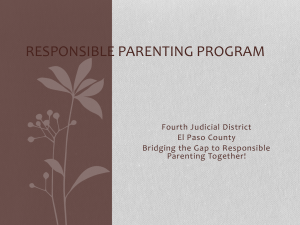Evidence-Based Parenting Programs supported by Children`s
advertisement
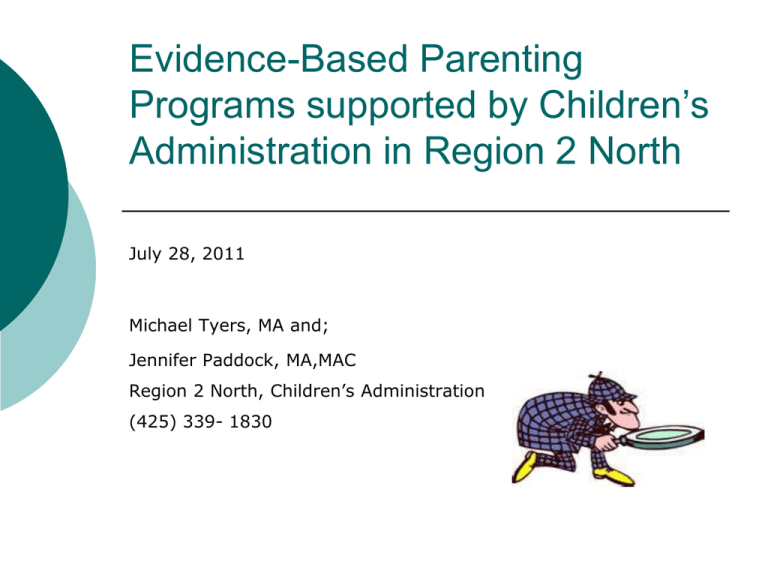
Evidence-Based Parenting Programs supported by Children’s Administration in Region 2 North July 28, 2011 Michael Tyers, MA and; Jennifer Paddock, MA,MAC Region 2 North, Children’s Administration (425) 339- 1830 What constitutes an EvidenceBased Program? In Washington State we follow the California Evidence-Based Clearinghouse for Child Welfare (CEBC) CEBC rating scale is to evaluate each practice based on the: Best research evidence Best clinical experience Consistency with patient (family/client) values. Programs covered in this presentation: NCAST Assessments Promoting First Relationships Project SafeCare Incredible Years Triple P- Positive Parenting Program Homebuilders-Intensive Family Preservation Services Wrap-Around High-Fidelity Parent Child Interaction Training (PCIT) Functional Family Therapy Nursing Child Assessment Satellite Training (NCAST) Valid and reliable measure for assessing parent-child interaction Describes observable behavior brought to the interaction by caregiver and child Easily identifies strengths as well as areas needing improvement The most widely used scales for measuring parent-child interaction today, birth to age 3. PCI Subscales Assesses Child and Parent in the 1. Feeding Element for up to age 1 2. Teaching Element for up to 3 years of age Four subscales describe the parent's responsibilities to the interaction. Two subscales describe the child's responsibilities. Parent Subscales Sensitivity to Cues Response to Distress Social-Emotional Growth Fostering Cognitive Growth Fostering Child Subscales Clarity of Cues Responsiveness to Caregiver Typical cases referred for NCAST To evaluate the adequacy of the caregiver-child interaction, of the caregiver style, ability or the environment Failure to thrive? Determine the need for an intervention plan for the caregiver-child pair Drug positive baby at birth Assess responsivity between caregiver and child Promoting First Relationships (PFR) Promoting First Relationships is a prevention program dedicated to promoting children's socialemotional development through responsive, nurturing caregiverchild relationships. Appropriate for ages birth to 3. Features of the PFR training program include: Videotaping caregiver-child interactions to provide insight into real-life situations. Giving positive feedback that builds caregivers' competence with and commitment to their children. Focusing on the deeper emotional needs underlying children's challenging behaviors. What happens during the 10 sessions? Caregivers learn about 10 basic social and emotional needs infants/toddlers have. Caregivers learn behaviors that help create healthy attachments Staying connected with infants and toddlers during difficult times is also discussed Where challenging behaviors come from in infants and toddlers How to reach out and get support Building reflective capacity through video taping parent-child interactions Project SafeCare Project SafeCare is a parent-training curriculum for parents who are at-risk or have been reported for child maltreatment. The program is appropriate for children birth to 5. Through SafeCare, trained professionals work with at-risk families in their home environments to improve parents’ skills in several domains. The Project SafeCare Modules 1. Parent-child or parent-infant interaction 2. Child Health 3. Home Safety and cleanliness 4. Problem Solving worksheet Common Elements of each PSC module: Describe desired target behaviors Explain the rationale or reason for each behavior Model each behavior (demonstrate desired behavior) Ask parent to practice behavior Provide positive feedback (point out positive aspects of performance) Provide constructive feedback (point out aspects of performance needing improvement) Review parent's performance, have them practice areas that need improvement, and set goals for the week. Incredible Years Appropriate for ages birth – seven Families have a need to learn appropriate parenting skills & discipline or improve bonding Short Term Objectives To prevent and reduce aggression and behavior problems in young children. To promote social, emotional and academic competence in young children. Long Term Objectives To prevent delinquency, substance abuse and violence in adolescence. The BASIC IY program Incredible Years Basic Preschool Program 18 group sessions (for high risk populations) Increase developmentally appropriate & nurturing parenting practices Persistence, academic, social and emotional coaching & child directed play Praising and Motivating Children The BASIC IY program continued… Predictable routines & schedules Using non-punitive and more consistent discipline approaches for misbehavior Learning how to help children self-regulate, use appropriate social skills, problem solve & develop imaginary play Promoting parent-teacher collaboration Incredible Years Parenting Program Group Methods & Process Developmentally based Culturally sensitive Emphasizes the therapeutic relationship: “collaborative process” Coping (vs. Mastery model) Video modeling/DVDs Role play practice & rehearsal Home assignments Group support Sensitive to socioeconomic barriers Research tells us: Parent training remains the single most effective strategy for preventing behavior problems and promoting social and emotional competence in young children! Triple P- Positive Parenting Program Appropriate for birth to 12. The program is based on self-regulation. The goals are for children to develop emotional self-regulation and for parents to become resourceful, independent problem-solvers. As families determine their own particular goals, the program is tailored to suit their aspirations. Practitioners consult and guide through active skills training. Parents decide what they wish to take on. Triple P levels for Child Welfare involved Families. Standard Triple P This 10-session program incorporates sessions on causes of children’s behavior problems, strategies for encouraging children’s development and strategies for managing misbehavior. Skills training includes: modeling rehearsal self-evaluation homework tasks Home or clinic practice sessions are also conducted in which parents self-select goals to practice. They are then are observed interacting with their child and implementing parenting skills, and subsequently encouraged to selfevaluate their progress toward meeting their goals. Homebuilders-Intensive Family Preservation Services Appropriate for birth to 18 One of the oldest and best documented programs in the U.S. Intensive in-home crisis intervention, counseling and life skills education. Homebuilders Elements One or more children is in imminent danger of being placed out of home or is returning home from placement. Client seen within 24 hours of referral Treatment is in home and therapists are responsive 24/7. Targeted 4 week concentrated service. Therapist are flexible and carry only 2-3 cases at a time. Service is in-home and averages 40-50 hours of direct service. Homebuilders continued… Therapist has flexibility to address crisis in variety of ways: 1. Food, clothing, gas 2. Shelter 3. Transportation 4. Parent skill training 5. Counseling (Financial, Anger, Development, Communication etc.) Parent Child Interaction Training (PCIT) PCIT is appropriate for ages 2-7. PCIT is a parent training program that: helps parents improve parenting skills helps establish a warm and responsive relationship with their child helps to decrease child behavior problems PCIT continued: The service includes: 20 weeks of individualized, one-hour parent-child sessions Trained therapists coach the parents: use of a one way mirror in which therapist uses a microphone device from another room in clinic completed in family’s home Child management techniques include: praising appropriate behavior ignore undesirable behavior give clear age-appropriate instructions appropriate discipline methods High Fidelity Wraparound Program Currently a Promising Practice moving towards becoming Evidence-Based. Appropriate for ages 3 to 17. Provides a community-based team that focuses on the “voice and choice” of the family. Wraparound Program continued… Family focused approach that assesses family and individual strengths, natural supports and cultural importance's. Wraparound Principles Family and Youth Voice Unconditional/Persistent Strength Based Culturally/Linguistically Competent Community Based Individualized Natural Supports Collaboration Team based Outcome based Phases of Wraparound Program 1. 2. 3. 4. Phase One; Engagement and Team Preparation Initial Plan Development Plan Implementation Transition Services and support are offered through multiple community agencies Functional Family Therapy (FFT) Appropriate for ages 11-18. FFT is a family therapy that is provided usually in a family home. FFT focuses reducing conflict in the family, improving communication, increasing use of age appropriate parenting skills, and improving parent supervision of children. The program lasts an average of 4 months. The entire family participates in FFT. FFT Service Steps Step 1- Case Processing Gather client information, establish appointment times with the family Step 2- Engagement and Motivation Initial face to face meeting, increase family’s interest and motivation for change Conduct assessments Step 3- Behavioral Change, Generalization and Closure Individualized change plans that reduce risks and increase protective factors, relapse plan developed and family/community connections established to sustain treatment gains. Thank you for attending Evidence-Based Parenting Programs supported by Children’s Administration in WA State
